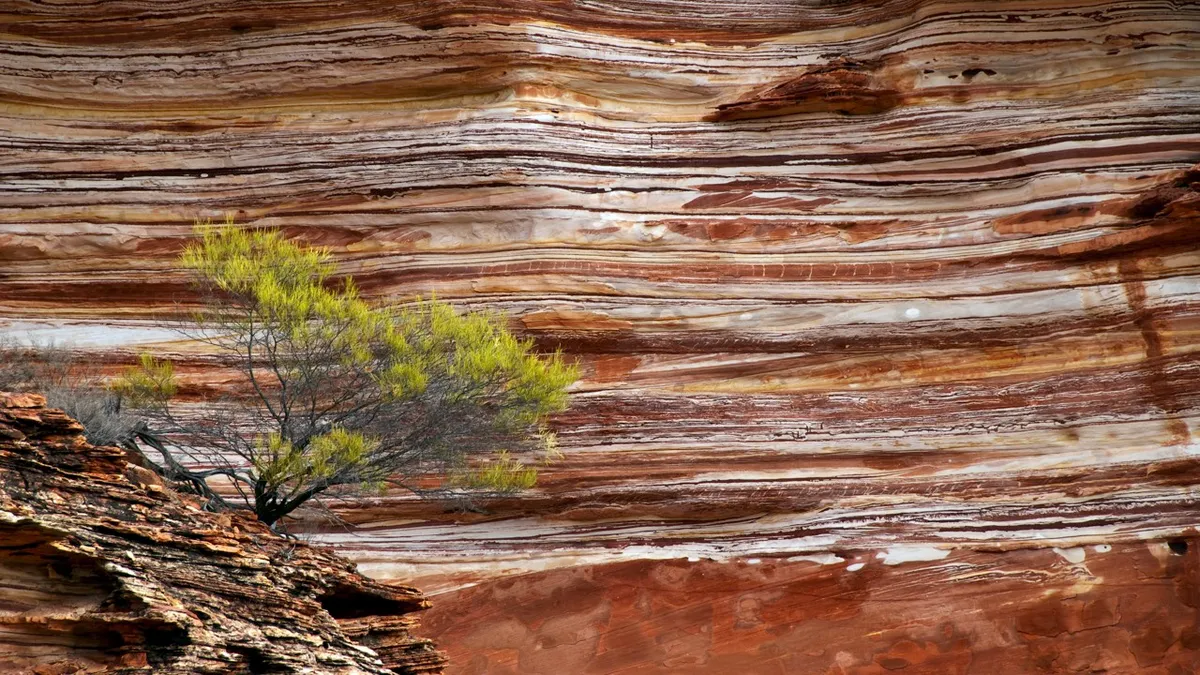Strolling along London’s South Bank, the monumental stone buildings of Westminster, concrete bulk of the National Theatre and distant skyscrapers of Canary Wharf feel like an enduring testament to human achievement.
Over the last century, mankind has transformed the surface of the planet, an impact so lasting that they define a proposed new geological epoch: the Anthropocene – the ‘age of man’. Like other geological eras, evidence for the Anthropocene will be left in layers of rock. But what, exactly, would be left behind if mankind were to suddenly die out and an alien geologist examined our planet in the far future? Would it be remnants of our towns and cities? Or less tangible changes to Earth’s atmosphere, oceans and biosphere?The answer might surprise you. “Not all of these features will be present in the future geological record,” says Dr Jan Zalasiewicz of the University of Leicester.
Earth without mankind is hard to imagine, although it’s possible we might leave to colonise other planets and moons, or simply go extinct. There have already been five mass extinctions in the history of the Earth. If the asteroid impact that killed the dinosaurs happened today, for instance, the dust kicked up from the catastrophic collision would block out sunlight long enough to bring about worldwide crop failure.
So what would happen then? Our current infrastructure of roads and cities certainly looks solid, but they also require maintenance. Take away the people and fast-forward 500 years, and London will be wearing away: the embankments that confine the Thames will fail in a few centuries – water will flood the sewers and Underground network, eroding the foundations of the buildings above. If you also consider rising sea levels and the corrosive effects of rainwater, then modern buildings are more vulnerable than the Pyramids at Giza. Within tens of thousands of years, our government offices and gleaming financial districts will have collapsed into landscapes of rubble.
But mankind has done more than build cities. We’ve also changed the chemistry of the oceans and the atmosphere by burning fossil fuels, exploiting nuclear energy and manufacturing materials. We’ve shaped the landscape, moving three times more sediment than rivers. We domesticated animals and cultivated plants, replaced forests with farmland and have become the world’s top predator, limiting biodiversity on land and sea. But which of these changes will be recorded in the rocks?
Rock bands
Geologists deduce the relative ages of rocks from observations in the field, starting with the fact that younger sedimentary rocks form on top of older ones. Identifying younger and older layers, often using fossils, leads to a local sequence of geological layers that can be compared with others to build up a worldwide timescale.
Significant environmental changes are marked by unusual layers or abrupt alterations in the nature of the sediments. The branch of geology that studies layers is known as stratigraphy. “Stratigraphic changes happen when the world changes comparatively fast,” says Zalasiewicz.
Where a change appears simultaneously worldwide, it becomes a boundary. The boundary between the Cretaceous and Palaeogene periods, for example, is a thin band of rock unusually rich in the element iridium, which is thought to come from that cataclysmic asteroid impact 65 million years ago. Stratigraphers like Zalasiewicz say that such records in the rock can be used to work out what happened before and after a boundary. “We think that it can be done for the Anthropocene, on the basis of recent sediments laid down over decades and centuries.”
And there’s one clear candidate for a global mark of mankind: the testing of atomic bombs in the 1950s. The radioactive fallout arising from these explosions originated in a narrow time period and quickly spread worldwide, generating long-lived radioactive signatures that, like the iridium anomaly, would create a distinctive boundary.

But if the Anthropocene is characterised by changes that humans have made to the environment, then our geological epoch started even earlier. This was the finding of geochemist Christopher Vane of the British Geological Survey, whose team sampled the estuaries of rivers such as the Clyde and Thames. He found polymers that indicate the burning of coal and petrol, plus manufactured compounds like flame retardants and chlorinated chemicals used in electronics. These compounds, recorded in the mud over two centuries, reveal the Industrial Revolution.
But while the growth of industry produces new materials that could endure in the long-term, it doesn’t happen in every society at the same time. Stratigraphers call such changes ‘diachronous’ – they occur at different times in different places.
Industrialisation offers a strong signal of the Anthropocene, but it’s inconsistent. Urbanisation accompanies industrialisation, but few recognisable features of our cities will last. Seafloor sediments survive much better than those on land – two-thirds of Britain’s sedimentary rocks formed under the sea – so cities need to be located in subsiding regions for their debris to withstand the effects of erosion from rain.
Rare metals such as lithium, mined and concentrated for use in electronics, will be carried away by rivers and become an unusual feature of marine sediments. City rubble will produce strange sedimentary rocks that would be made from fragments of the exotic polished materials that decorate our prestigious buildings.
On top of this, massive structures will leave their mark in undersea sediments. Creatures living in soft sediment churn up surface layers to produce fossil features known as bioturbations. According to Zalasiewicz, our industrial infrastructure will create something similar but on a huge scale – what he calls ‘megabioturbations’. “Fossilised subways and foundations will be distinctive – anyone in the future who looks at strata as we do will see a difference,” he says.
Future geologists might also discover fossilised rubbish. While an object itself might decay relatively quickly, it could leave an impression in the surrounding sediment that preserves its shape. Bottles, coke cans and even MP3 players would look a little like trilobites.
Acidic oceans
“The whole ocean floor will record what’s happening,” says Professor Andy Ridgwell of Bristol University, who predicts that ocean acidification will be a tell-tale signal of worldwide atmospheric change. “It’s a massive marine geological impact.”
The creation of more acidic oceans will be driven by the CO2 generated by human activity, which will create a layer of calcium carbonate, or limestone. “If geologists come along in 50 million years, the thing that will be obvious is the carbonate layer,” says Professor Ken Caldeira, a climate scientist at Stanford University in California. Caldeira calculates that the carbon that humans have added to the atmosphere as CO2 will eventually form 37,000 cubic-kilometres of limestone – enough to leave a layer of limestone 30cm thick covering a third of the ocean floor.
And if future geologists drilled down through the floor, they’d see signs of acidification with a layer of dissolved carbonate worldwide. “There will be carbonate deposition, as the next hundreds of thousands of years see all of our carbon dioxide dumped,” say Caldeira.
Ridgwell likens this potential signature of the Anthropocene from today’s oceans to the pattern of limestone formation from a 56-million-year-old event: the ‘Paleocene-Eocene thermal maximum’ – the most extreme change in Earth’s surface conditions since the extinction of the dinosaurs. “The increase in atmospheric carbon was comparable to our fossil fuel release, so we can expect to see a similar response,” he says. “But the speed of change now is unusual.”

Speed also matters for biodiversity, as extinction is not only measured by the proportion of existing species that go extinct. “In terms of magnitude, we’re not living in a mass extinction – we’re not even close,” says Professor Charles Marshall, a palaeobiologist at the University of California, Berkeley. “But if we go by the rate of extinction, we seem to be already exceeding most of them.” According to Marshall, if humans were to suddenly vanish today, many endangered species would recover quickly.
Overall then, it seems that we’ve changed the world, but not by much. Based on our activities so far, future stratigraphers would see the Anthropocene as a layer of limestone marking an unusual – but not extreme – climate episode. The odd long-lived trace of radioactivity from nuclear tests might provide a worldwide marker, while our rubbish and modifications to the landscape might also survive as a sign of human activity.
Geologically speaking, it seems we’re not making much impact at the moment. As Zalasiewicz points out, however, climate change may lead to a different story in the future. “If we carry on with business as usual, in a few decades we’ll see change on a scale not known for millions of years.”
Follow Science Focus onTwitter,Facebook, Instagramand Flipboard
